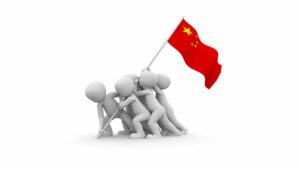Too much like Cao Cao: China’s claim for territories

Cao Cao was a fiery Chinese warlord and a shrewd politician who strategized his rise to power towards the turbulent end of the Eastern Han dynasty. He effectively became head of the Han central government during that period by holding the young emperor Xian under his control. Cao Cao fought and won several wars purportedly to regain territories of the Han which were threatened to be taken by rebel groups. He expanded territory for himself until it became the state of Cao Wei, established by his son and successor Cao Pi, to whom the Han emperor eventually ceded power and control.
It was Cao Cao’s own lust for power and territory that spearheaded the preliminary partitioning of the divided China into the Three Kingdoms, until all coalesced under the Jin dynasty. These three kingdoms, Wei, Shu, and Wu, battled for control in a long series of wars. This was one of the bloodiest times in Chinese history — according to census data, the population decreased from 50 million to 16 million (lumenlearning.com).
The Romance of the Three Kingdoms is a 14th century historical novel by Luo Guanzhong that romanticizes this period, which ran from 220–280 BCE in China. It is one of the four classics in ancient Chinese literature, along with Journey to the West, Water Margin, and Dream of the Red Chamber.
The ambitious and ruthless general Cao Cao, depicted as a thoroughgoing villain, ruled the north. Liu Bei, who is descended from Han emperors but grew up in poverty, is portrayed as virtuous. He becomes emperor of the Shu-Han dynasty and attempts to keep the Han alive after Cao Cao’s son, Cao Pi, is ceded the throne and founds the brief Wei dynasty. Sun Quan controls the south and eventually becomes the first emperor of the Wu dynasty. He is portrayed in Romance of the Three Kingdoms as being marginalized or in shaky alliances with Cao Cao or Liu Bei (according to britannica.com).
Cao Cao is the main antagonist in this classic epic as in history — strategizing and fighting, intimidating and betraying friends and foes alike. He had ordered the execution of hundreds, with no regard for rank or nobility, nor culpability. He personally lopped off the heads of those who betrayed him or even simply disappointed him. His ruthlessness and cruelty were not only folklore but factual history — around this time, Cao Cao had the famous literary scholar Kong Rong put to death along with his family — for “insouciance” (carefree idleness, or in Pilipino, “tamad”). So the story goes.
Annotations to Records of the Three Kingdoms (Chen and Pei, 1977) points out that through to modern times, the Chinese equivalent of the English idiom “speak of the Devil” is “speak of Cao Cao and Cao Cao arrives.”
“After the Communists won the Chinese Civil War in 1949, there were perceived similarities between Mao Zedong and Cao Cao, so propagandists began a long-term and sustained effort to improve Cao Cao’s image in popular culture. In 1959, Peng Dehuai wrote a letter to Mao, in which he compared himself to Zhang Fei (brother of Lu Bei, enemy of Cao Cao). Because of Mao’s popular association with Cao Cao, Peng’s comparison implied that he had an intuitively confrontational relationship with Mao. Mao had the letter widely circulated in order to make Peng’s attitude clear to other party members and proceeded to purge Peng and end his career” (Chen and Pei, op. cit.).
Today, China seems like Cao Cao as it continues to try to expand its territory beyond its boundaries. Since 1947, China has been wanting to own the entire South China Sea and its islands and reefs.
China, under the rule of the nationalist Kuomintang party, demarcated its territorial claims in the South China Sea with an 11-dash line on a map. The claim covers the majority of the area, including the Pratas Islands, the Macclesfield Bank, and the Paracel and Spratly Islands, which China regained from Japan after World War II. The People’s Republic of China (PRC) was established in 1949, and Communist leader Mao Zedong (a.k.a. Cao Cao according to oppositionist Peng Dehuai) reconfirmed the 11-dash line territorial claims. In 1953, the Chinese Communist Party (CCP)-led government removed the portion encompassing the Gulf of Tonkin, simplifying the border to nine dashes. To this day, China invokes the nine-dash line as the historical basis for its territorial claims in the South China Sea.
In 1974, a year after the Paris Peace Accords which ended US involvement in the Vietnam War, China forcibly occupied the western portion of the Paracel Islands, planting flags on several islands and seizing a South Vietnamese garrison. Beijing built a military installation, including an airfield and artificial harbor, on Woody Island, the largest of the Paracels. After the fall of Saigon and the reunification of Vietnam, the newly formed Socialist Republic of Vietnam upheld the South’s former claims to the Spratlys and Paracels. To this day, China maintains around 1,000 troops in the Paracels. (timeline from cfr.org.)
In 1988, after roughly a decade of relative calm in the South China Sea, China and Vietnam clashed on the Johnson Reef, marking China’s first armed conflict over the Spratly archipelago. The Chinese navy sank three Vietnamese vessels, killing 74 sailors in one of the most serious military confrontations in the South China Sea. This was after Beijing, pursuing a more assertive stance in the area, established a physical presence on Fiery Cross Reef in the Spratlys in January 1987.
After three decades of negotiations, the third and final United Nations Conference on the Law of the Sea, or UNCLOS, made a resolution on Nov. 14, 1994, that defined the rights and responsibilities of nations in their use of surrounding waters based on exclusive economic zones (EEZ) and continental shelves. However, UNCLOS does not address sovereignty issues related to the South and East China Seas, and its vague wording has prevented it from serving as a credible body of law in resolving territorial disputes.
China signed the UNCLOS text in 1982 (when it became a member of the United Nations and ratified it in 1996). Yet it continued to transgress the EEZs of other nations in the South China Sea, setting up military structures in reefs and creating islands within its self-serving nine-dash line demarcation.
The Philippines initiated an international arbitration case under UNCLOS over Chinese claims of sovereignty to the Spratly Islands and Scarborough Shoal originating from the April 2012 clashes, acting on decades of stalled attempts at resolution. China rejected the process, forcing the court and its arbitration to continue without its participation. On July 12, 2016, the Arbitral Tribunal in the South China Sea Arbitration (The Republic of the Philippines v. The People’s Republic of China) issued a unanimous award largely favorable to the Philippines. The tribunal found China’s declared “nine-dash line” to have no legal basis for its claims to historic rights to resources in the South China Sea (sections renamed “West Philippine Sea” by the Philippines in 2011). The case marked the first time a country has brought a claim against China under UNCLOS regarding the issue.
Still, skirmishes with Chinese vessels frequently happened in the South China Sea/West Philippine Sea. “In 2020, the first year of the COVID-19 pandemic, Beijing was especially abrasive in the South China Sea — the North Natuna Sea run-in with Indonesia, standoff over the West Capella oil drilling platform with Malaysia off Sarawak, and into early 2021, Whitsun Reef incident with the Philippines then under the helm of a relatively Beijing-friendly Duterte administration” (channelnewsasia.com, Sept. 19, 2023).
At the end of August 2023, China’s Ministry of Natural Resources released an updated official map of the geographical territories that the People’s Republic of China (PRC) now claims. This map, departing from the previous nine-dash line standard, now includes a tenth dash, the placement of which officially encompasses the island of Taiwan into its core territory, reinforcing that and other claims made by the PRC in Southeast Asia (bostonpoliticalreview.org, Dec. 22, 2023).
“I control the world,” the ruthless strategist Cao Cao said in The Romance of the Three Kingdoms. “I’d rather let the world down than to allow the world to let me down.”
Amelia H. C. Ylagan is a doctor of Business Administration from the University of the Philippines.




